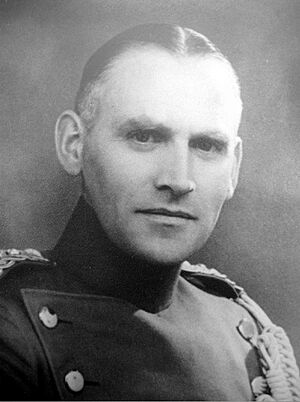Hans Lunding facts for kids
Quick facts for kids
Hans Lunding
|
||||||||||||||||||||||
|---|---|---|---|---|---|---|---|---|---|---|---|---|---|---|---|---|---|---|---|---|---|---|

Lunding in 1932
|
||||||||||||||||||||||
| Birth name | Hans Mathiesen Lunding | |||||||||||||||||||||
| Born | 25 February 1899 Stepping, German Empire (now part of Denmark) |
|||||||||||||||||||||
| Died | 5 April 1984 (aged 85) Århus, Denmark |
|||||||||||||||||||||
| Branch | ||||||||||||||||||||||
| Rank | Colonel | |||||||||||||||||||||
| Commands held | Chief of Defence Intelligence Service | |||||||||||||||||||||
|
||||||||||||||||||||||
Hans Mathiesen Lunding (born February 25, 1899 – died April 5, 1984) was a brave Danish officer. He was also a talented horse rider, a hero in the resistance against the Nazis, and a leader of Denmark's military intelligence.
Contents
Hans Lunding's Early Life and Army Career
Hans Lunding was born on February 25, 1899, in Stepping, Denmark. At that time, this area was part of Prussia. In 1916, during World War I, he was drafted into the Prussian army. He became a non-commissioned officer by the end of the war.
From 1919 to 1920, Lunding worked as a police officer. He helped an international group that was supervising a vote in Schleswig. This vote decided if the area would be part of Denmark or Germany.
Lunding joined the Danish Army in 1922. He became a lieutenant in Aarhus in 1927. He also went to a special Riding School from 1928 to 1929. Later, he completed a General Staff Course from 1933 to 1935. He then worked in the General Staff's intelligence department.
Olympic Success in Horse Riding
Hans Lunding was also a skilled horseman. At the 1936 Summer Olympics in Berlin, he won a bronze medal. He competed in an event called eventing with his horse, Janus. This was a great achievement for him and for Denmark.
Hans Lunding's Role in World War II
Before Germany attacked Denmark and Norway on April 9, 1940, Lunding was at the border. He saw German troops getting ready to invade. He reported what he saw to Copenhagen. However, the Danish government did not take action.
Arrest and Imprisonment
On August 29, 1943, the Danish Army and Navy were dissolved by the Germans. This event was called Operation Safari. Lunding was arrested by the Gestapo, the German secret police. He was accused of secretly going to Stockholm to meet British and Polish intelligence officers. This was true, as he was part of the Danish resistance.
Lunding was taken to Berlin. There, the Gestapo chief told him he was sentenced to death. Heinrich Himmler, a very powerful Nazi leader, would decide when and how he would be executed.
Lunding spent almost a year in a Gestapo prison in Berlin. Then, he was moved to the Flossenbürg concentration camp. For a while, he was in a cell next to Admiral Wilhelm Canaris. Canaris was the chief of German military intelligence. Lunding and Canaris could talk by knocking on the walls. Lunding was the last person to communicate with Canaris before Canaris was executed on April 9, 1945.
Survival and Release
As the Allied armies got closer to Flossenbürg, the prisoners were moved. Lunding was taken to the Dachau concentration camp. In the last days of the war, Lunding was one of 139 special prisoners. They were transported by the SS to Villabassa in South Tyrol.
On April 29, a German prisoner, Colonel Bogislaw von Bonin, helped the group. He placed them under the protection of a German army unit. A few days later, the group surrendered to American troops. Hans Lunding was finally free.
Post-War Life and Leadership
After returning to Denmark, Lunding rejoined the Danish army. He was promoted to Lieutenant Colonel. From 1945 to 1950, he worked as a liaison officer. He connected the Danish government with the British military in the Schleswig region.
In 1950, he was promoted to Colonel. He became the first head of Denmark's combined army and naval intelligence services. He led this important service until he retired in 1963.
Hans Lunding passed away on April 5, 1984, in Aarhus, Denmark, at the age of 85.

